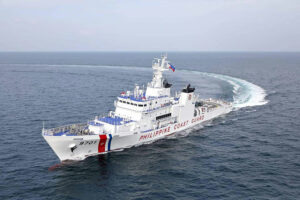Philippines to continue patrols in disputed water
THE PHILIPPINES will continue sending coast guard ships and reinforcement to Sabina Shoal in the South China Sea, where China is allegedly doing small-scale reclamation, a top security official said on Monday.

By Kenneth Christiane L. Basilio, Reporter
THE PHILIPPINES will continue sending coast guard ships and reinforcement to Sabina Shoal in the South China Sea, where China is allegedly doing small-scale reclamation, a top security official said on Monday.
“We can send a ship, and we can send Air Force planes,” National Security Council (NSC) Assistant Director-General and spokesman Jonathan E. Malaya told BusinessWorld in an interview in Filipino.
“It’s really the Coast Guard who’s doing the maritime [patrols],” he added, noting that military assets would only be used to provide support.
Mr. Malaya said the Armed Forces of the Philippines (AFP) would always be just on the sidelines, “in the same manner that the Chinese Coast Guard is accompanied by the People’s Liberation Army Navy from afar.”
“We are using all our surveillance capacities,” he added.
BRP Teresa Magbanua on Sept. 14 left Sabina Shoal, which Manila used as a staging ground for resupply missions to Second Thomas Shoal, because it had accomplished its mission, the Philippines’ National Maritime Council said last week.
The Chinese Coast Guard confirmed the departure of the ship after lingering there since April in what China viewed as an “illegal action,” according to state-owned Xinhua News Agency.
China took measures against Philippine vessel 9701 in accordance with the law, while repeated Philippine attempts to organize replenishment of the vessel had failed, Xinhua quoted China Coast Guard spokesman Liu Dejun as saying.
The Southeast Asian nation’s sustained presence at the feature, aiming to monitor what it suspects to be China’s small-scale reclamation activities has angered Beijing, turning the shoal into their latest flashpoint in the contested waters.
Mr. Malaya, who attended a House of Representatives budget hearing for the NSC, said the Philippines had sent another ship to Sabina Shoal to replace BRP Teresa Magbanua, the Philippine Coast Guard’s (PCG) biggest ship, “because it’s part of our exclusive economic zone, and it’s our right to monitor what’s happening there.”
Mr. Malaya said the new vessel was sent there to check on China’s reclamation activities at the disputed shoal.
He said the PCG now has the capacity for long-term deployment, but from here on, Manila prefers not to broadcast its plans.
“We no longer want to disclose how long that ship will be there, the Philippine government has been criticized of being loud compared with China, which prefers to keep silent,” Mr. Malaya said. “So we also don’t want to telegraph our punches to China.”
The Philippine Foreign Affairs department this month said it had expressed its displeasure with Beijing over an Aug. 31 collision in which BRP Teresa Magbanua was hit thrice by a Chinese vessel.
The Chinese Coast Guard vessel had caused significant damage to the Philippine ship and endangered the lives of its personnel, a Philippine task force said.
The Chinese side made a similar claim, with Mr. Liu saying that the smaller PCG vessel “deliberately” collided with their ship.
Sabina has been a staging ground for Philippine resupply missions to Second Thomas Shoal, where Manila grounded a World War II era ship in 1999 to serve as an outpost for a handful of Filipino soldiers.
Manila and Beijing came up with a resupply deal in July after a June 17 standoff where Chinese forces threatened, using bladed weapons, Filipino troops delivering supplies to the Navy outpost, according to the Philippine military.
China claims sovereignty over most of the South China Sea, overlapping into maritime zones of Brunei, Indonesia, Malaysia, the Philippines, and Vietnam.
In 2016, a United Nations-backed tribunal in the Hague voided China’s expansive claims for being illegal. Beijing has ignored the ruling.
Sabina Shoal is about 140 kilometers (km) away from the Philippine island of Palawan and about 1,200 km from Hainan island, the nearest major Chinese landmass.












